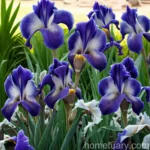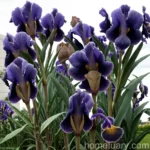The Fascinating World of Bearded Iris (Iris ‘Monty’s Sweet Blue’)
What is a Plant: Bearded Iris (Iris ‘Monty’s Sweet Blue’)?
Bearded iris, scientifically known as Iris germanica, is a stunning flowering plant that belongs to the Iridaceae family. Its botanical name has been derived from the Greek word for rainbow, indicating the wide range of flower colors found within this genus. The name “bearded iris” refers to the fuzzy strip on each of the falls, which brings charm and character to this plant.
Key Takeaways – Bearded Iris (Iris ‘Monty’s Sweet Blue’)
Before diving into the specifics of this beautiful plant, it’s important to highlight some of the key takeaways:
- Scientific Name: Iris ‘Monty’s Sweet Blue’
- Family: Iridaceae
- Common Name: Bearded Iris
- Variety: Monty’s Sweet Blue
- Characteristics: Stunning and diverse flower colors, fuzzy strip on falls
- Growth Habit: Herbaceous, rhizomatous perennial
Now, let’s delve deeper into the various aspects of the bearded iris, from its culture and uses to its propagation and common pests.
Culture
Water
Bearded irises have different water requirements during different seasons of their growth cycle. It’s critical to provide adequate water for these plants, especially during their active growth and blooming periods in spring and early summer. However, it is equally important to ensure that the soil is well-drained to prevent waterlogging, which can lead to root rot and other diseases. During the dormant season, minimal watering is ideal to prevent excessive moisture.
Sunlight
Bearded irises thrive in full sun, requiring at least 6 hours of direct sunlight to achieve their full potential. In regions with scorching summers, some protection from the intense midday sun may be beneficial. Adequate sunlight promotes robust flowering and overall plant vigor.
Fertilizer
A balanced fertilizer with a higher proportion of potassium (the third number in the N-P-K ratio) is beneficial for bearded irises. Fertilization should be done in early spring when new growth emerges. Avoid excessive nitrogen, as it can lead to lush foliage at the expense of blooming.
Soil
These iris varieties prefer well-draining, slightly alkaline soils. Incorporating organic matter such as compost into the soil before planting can be beneficial. A slightly raised bed can also help in ensuring good drainage.
Uses
Bearded irises are versatile plants with a wide range of uses in gardens and landscapes:
- Garden Borders: Their vibrant flowers add a pop of color to garden borders, creating a visually stunning display.
- Cut Flowers: The long stems of bearded irises make them an excellent choice for cut flower arrangements, bringing their beauty indoors.
- Landscaping Focal Points: These plants can be used as focal points in landscaping, drawing attention to specific areas of the garden.
Now, let’s take a closer look at some vital aspects of growing and caring for the magnificent bearded iris, Iris ‘Monty’s Sweet Blue’.
Pruning
Pruning bearded irises is a straightforward task. After the flowering period, it’s essential to remove spent flower stalks to prevent the plant from expending unnecessary energy on the development of seeds. Additionally, if the foliage shows signs of disease or damage, it can be trimmed to maintain the overall health and aesthetics of the plant.
Propagation
Division
Division is a common method of propagating bearded irises. It involves separating the rhizomes of mature plants into smaller sections, each with healthy roots and fan-like foliage. This process should be carried out every three to four years to rejuvenate the plant and prevent overcrowding.
Container
Bearded irises can also be grown in containers, providing an opportunity for gardeners with limited space to enjoy these beautiful plants. When growing in containers, ensure that the pots have drainage holes to prevent waterlogging, and use a well-draining potting mix.
Popularity
Bearded irises, including the captivating Iris ‘Monty’s Sweet Blue’, are popular among gardeners and landscaping enthusiasts for several reasons:
- Diverse Colors: They are available in a wide array of stunning colors, catering to various aesthetic preferences.
- Low Maintenance: Once established, they require minimal maintenance, making them ideal for both experienced and novice gardeners.
- Versatility: From garden beds to containers, bearded irises can thrive in various settings, bringing their unique charm wherever they are planted.
Common Diseases and Pests
Diseases
- Leaf Spot: This fungal disease manifests as circular spots with a tan or gray center and brownish-purple margins on the leaves. Good air circulation and proper sanitation can help prevent the spread of leaf spot.
- Soft Rot: Excessive moisture can lead to soft rot, causing the rhizomes to become mushy and discolored. Providing well-draining soil and avoiding overwatering can mitigate the risk of this disease.
Pests
- Iris Borers: The larvae of iris borers feed on the iris rhizomes, resulting in wilting and yellowing of the leaves. Regular inspection and prompt removal of affected parts can help manage infestations.
Botanist’s Tips
Fun Facts
- Bearded irises are named for the distinctive fuzzy strip, or “beard,” on each of the falls.
- In ancient times, irises symbolized trust, hope, and wisdom, and were often associated with the Greek goddess Iris.
Links to External Resources
For further information on bearded irises, check out these valuable resources:
As we continue to explore the captivating world of bearded irises, let’s delve into additional essential aspects of their cultivation and maintenance.
Conclusion
In conclusion, the bearded iris, including the enchanting Iris ‘Monty’s Sweet Blue’, holds a special place in the realm of ornamental plants. From their vibrant and diverse flower colors to their minimal maintenance requirements, these plants offer a myriad of benefits to gardeners and landscaping enthusiasts. By understanding and implementing proper care practices, we can ensure that these remarkable plants thrive and continue to grace our gardens and landscapes with their elegance and charm.















